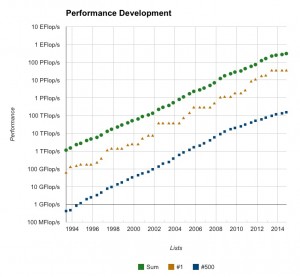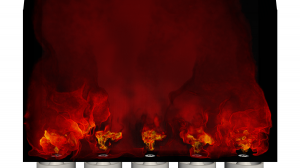High performance computing
High performance computing is a transverse activity at CERFACS involving all sectors. Since the institution of the Top500, the official listing of the most powerful super computers in the wolrd, a doubling of the peak performance is observed every four years. This increase of computational resources allows to tackle via numerical simulation ever more complex phenomena with increase precision if you are able to efficiently use the new technologies that allowed for this new performance.
All aspects of research at CERFACS benefit from this performance increase: Engine and turbine simulations, aeroacoustic studies, climate change prospective analysis, development of numerical methods and algorithms specifically for high performance computing, etc …
Technology watch
An important aspect of the high performance computing (HPC) activity at CERFACS relies on code modernisation and method adaptation to future architectures. This involves:
- A permanent technology watch on emerging architectures and applications.
- Code optimisation
- Adaptation and refactoring of current codes to new technologies
- New codes taking advantage of cuting edge numerical methods and algorithms.
Collaborations
This activity relies on:
- close collaborations with technology developers and providers.
- Close collaboration with Intel concerning AVBP optimisation for ManyCores environment,
- Close collaboration with IBM and Nvidia concerning codes optimisation on IBM Power and GPU environment,
- Collaboration with Lenovo concerning AVBP optimisation and its preparation for futures technologies,
- continuous porting and optimisation of applications on various architectures.
- Since 2014 CERFACS is identified by Intel as an “Intel Parallel Computing Center (Intel IPCC)”
- close collaboration with national and international computing centers.
- Cerfacs regularly participate to large supercomputers pre-production phase. In 2015, several major challenges from CERFACS have Highlighted the Occigen configuration of CINES and turing configuration of Idris
- Specific partner relationship linked CERFACS to CEA and CINES.
- Access to leadership class systems worldwide to develop and foster fringe simulations via international access programs (ex: PRACE, INCITE)
Examples
- Parametric ignition sequence of an aeronautic burner. Grand Challenge simulated on TURING (IDRIS/GENCI IBM BlueGene Q system). D. Barré, L. Esclaffez, G. Staffelbach, L.Y.M. Gicquel, E. Riber, B. Cuenot.
- Cyclone (here on Madagascar) visualised using the instantaneous OLR (Outgoing Longwave Radiation, exprimé en W/m2). Generated on the PRACE CURIE system using the NEMO-WRF model. CERFACS’ participation to the assembly of this model on the ANR project PULSATION.
- Confined domain explosion prediction – INCITE 2014 project. Argonne National Labs. – D. Barré, P. Quillatre, O.Vermorel, G. Staffelbach, D. Veynante, T. Poinsot





